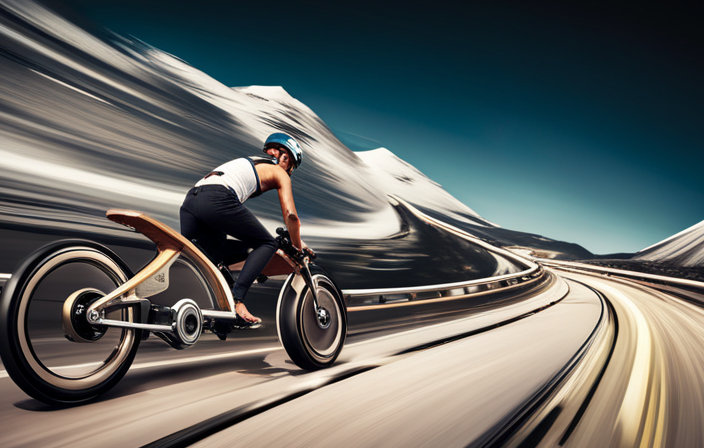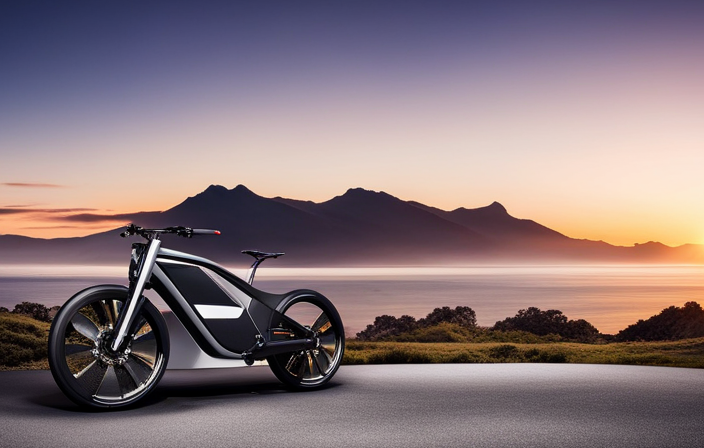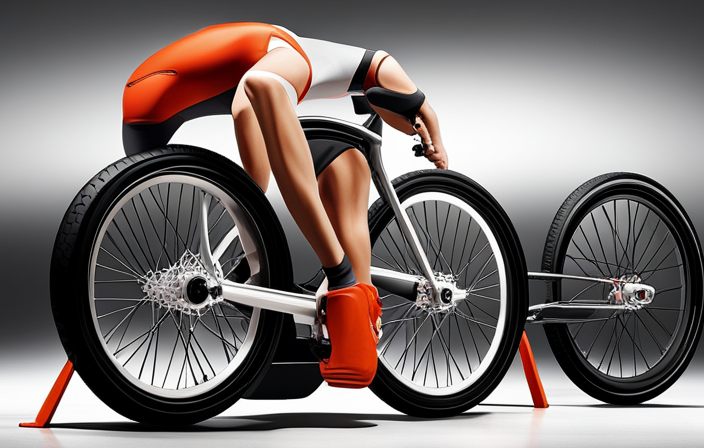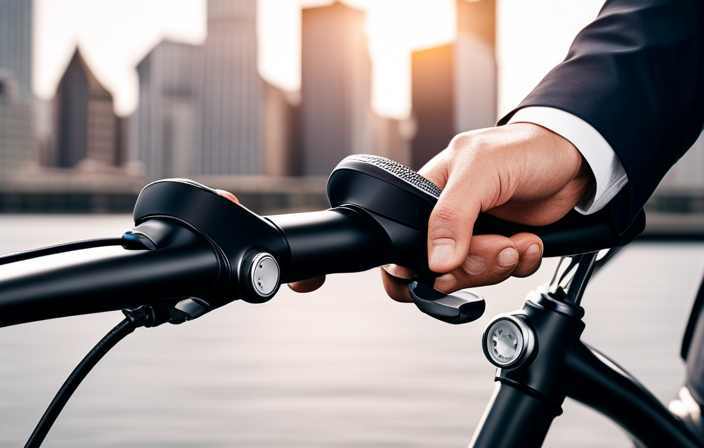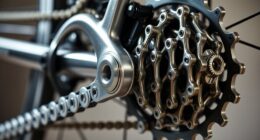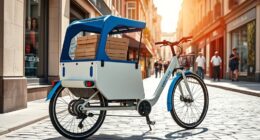As I ride my electric bike and feel the powerful surge beneath me, I can’t help but be amazed by the force of torque pushing me onward.
Torque, the twisting force that drives the wheels of an electric bike, is a crucial element in understanding its performance.
In this article, we will delve into the intricacies of torque, exploring its impact on speed, battery life, and range.
Join me as we uncover the fascinating world of torque in electric bike technology.
Key Takeaways
- Efficient motor converts more energy into torque, which extends the battery life of an electric bike.
- Aggressive acceleration and constant high torque demand drain the battery quicker, while a conservative riding style preserves battery capacity.
- Hilly terrains and rough surfaces increase torque demand and strain the battery, reducing its capacity.
- Customizing torque settings allows for a personalized riding experience, matching preferred cycling style and optimizing torque performance.
Understanding the Basics of Torque
To understand the basics of torque in an electric bike, you need to know how it affects the bike’s performance. Torque plays a crucial role in determining the acceleration of an electric bike. It is the rotational force that the motor produces to propel the bike forward.
The greater the torque, the faster the bike can accelerate. This connection between torque and acceleration is what makes torque management so important in optimizing power delivery. By effectively managing the torque output, manufacturers can ensure that the bike delivers power smoothly and efficiently, allowing for better control and performance.
Understanding how torque impacts electric bike performance is essential for riders to make informed decisions about the type of bike they need and how it will perform in various situations.
How Torque Impacts Electric Bike Performance
When it comes to electric bikes, torque greatly affects their performance. The impact of torque on acceleration is significant as it determines how quickly the bike can reach higher speeds. Torque is the rotational force that the motor generates, and it is what propels the bike forward. The higher the torque, the faster the acceleration.
However, torque alone is not the only factor affecting performance. The role of gear ratios is crucial in maximizing the efficiency of torque. By selecting the appropriate gear ratio, the motor can operate at its optimal torque range, ensuring a smooth and powerful acceleration.
Achieving the right balance between torque and speed is essential to optimize the bike’s performance. In the next section, we will explore how torque and speed can be balanced to enhance the overall riding experience.
Torque vs. Speed: Finding the Right Balance
Finding the right balance between speed and acceleration is crucial for enhancing your overall riding experience. In an electric bike, torque plays a significant role in achieving this balance. Torque is the force that rotates the wheels and determines how quickly the bike can accelerate. A higher torque allows for faster acceleration, while a lower torque may result in sluggish performance. However, it’s important to consider the relationship between torque and power consumption. Increasing the torque can lead to higher power consumption, which may impact the battery life and range of the bike. To help you understand this concept better, here is a table that illustrates the relationship between torque, acceleration, and power consumption:
| Torque (Nm) | Acceleration (m/s^2) | Power Consumption (W) |
|---|---|---|
| Low | Slow | Efficient |
| Medium | Moderate | Balanced |
| High | Fast | High |
As you can see, finding the right balance between torque and acceleration is essential to optimize the performance and power efficiency of your electric bike. Now, let’s explore the role of torque sensors in electric bikes.
The Role of Torque Sensors in Electric Bikes
Understanding how torque sensors work can greatly enhance your riding experience on an electric bike. Torque sensors play a crucial role in measuring the force applied to the pedals and delivering the appropriate amount of power from the motor.
The importance of torque in electric bikes lies in its ability to determine how quickly the bike accelerates and how efficiently it climbs hills. Torque sensors work by detecting the amount of force exerted on the pedals and translating it into an electrical signal. This signal then communicates with the motor controller, which adjusts the power output accordingly.
By accurately measuring torque, torque sensors ensure a smooth and responsive ride, allowing you to effortlessly tackle various terrains.
Now, let’s explore the factors that affect torque output in electric bikes.
Factors that Affect Torque Output
One factor that affects torque output in e-bikes is the level of resistance from the terrain. When it comes to optimizing torque output, there are several key factors to consider:
-
Gear ratio: Choosing the right gear ratio can greatly impact torque output. A lower gear ratio provides more torque for uphill climbs, while a higher gear ratio is better for flat terrain or downhill riding.
-
Motor power: The power rating of the motor directly affects the torque output. A higher power motor will generally deliver more torque, allowing for better acceleration and climbing abilities.
-
Battery voltage: Higher voltage batteries provide more power to the motor, resulting in increased torque output.
-
Rider weight: The weight of the rider can affect torque output, particularly when tackling steep hills. Heavier riders may require more torque to maintain speed and overcome resistance.
-
Tire traction: The type of tires and their traction on different surfaces can affect torque output. Tires with better grip can provide more traction, allowing for higher torque and better performance.
Considering these factors is crucial for optimizing torque output in e-bikes.
Now, let’s delve into how torque impacts the hill climbing abilities of electric bikes.
Torque and Hill Climbing Abilities
To improve your hill climbing abilities, it’s important to consider how the power of your motor impacts your ability to overcome resistance. When it comes to hill climbing techniques, torque and acceleration play a crucial role.
Torque, in simple terms, refers to the rotational force that a motor can produce. The higher the torque, the greater the ability of the motor to generate power and overcome resistance. This is especially important when climbing steep hills, as it requires a significant amount of torque to maintain speed and momentum.
Acceleration, on the other hand, determines how quickly the motor can increase its rotational speed. A motor with high acceleration can help you tackle uphill climbs more efficiently, allowing you to maintain a steady pace.
Understanding the relationship between torque and acceleration is key to optimizing your hill climbing abilities.
As we delve deeper into the relationship between torque and battery life, it becomes evident that there is a delicate balance to maintain. While a motor with high torque can enhance your hill climbing abilities, it can also have an impact on your battery life.
The increased power required to generate higher torque can drain the battery faster, reducing the overall distance you can travel on a single charge. Therefore, it’s crucial to find a balance between torque and battery life that suits your specific needs.
The Relationship Between Torque and Battery Life
Transition: Now that we understand the relationship between torque and hill climbing abilities, let’s explore how torque affects the battery life of an electric bike.
-
Battery Capacity: The torque produced by the motor directly impacts the battery life of an electric bike. Higher torque levels require more energy, leading to a faster depletion of the battery’s capacity.
-
Motor Efficiency: The efficiency of the motor is crucial in determining the battery life. A more efficient motor will convert a larger portion of the energy from the battery into useful torque, resulting in longer rides before recharging is required.
-
Riding Style: The way you use torque also affects battery life. Aggressive acceleration and constant high torque demand will drain the battery quicker than a more conservative riding style.
-
Terrain: Riding on hilly terrains or rough surfaces increases the demand for torque, putting additional strain on the battery and reducing its overall capacity.
As we delve into the topic of adjusting torque settings for a personalized ride, it is important to understand the impact of torque on battery life.
Adjusting Torque Settings for a Personalized Ride
When adjusting your torque settings, you can customize your ride to match your preferred style of cycling. Customizing torque settings allows you to optimize torque performance, ensuring that your electric bike delivers the power and responsiveness you desire. By adjusting these settings, you can fine-tune the amount of force applied to the pedals, providing a personalized riding experience. To help you understand the impact of different torque settings, here is a table showcasing the possible options and their corresponding effects:
| Torque Setting | Force Applied to Pedals | Power Output |
|---|---|---|
| Low | Gentle | Lower |
| Medium | Moderate | Moderate |
| High | Strong | Higher |
| Max | Maximum | Maximum |
As you can see, customizing your torque settings allows you to tailor your ride to your specific needs and preferences. Next, we will explore the relationship between torque and the impact on range.
Torque and the Impact on Range
As I mentioned earlier, adjusting torque settings on an electric bike can greatly enhance the riding experience.
However, it’s important to consider the impact torque has on range. Torque, in simple terms, is the rotational force generated by the motor to propel the bike forward.
When it comes to range, two key factors come into play: rider weight and motor efficiency. Heavier riders may require more torque to maintain a desired speed, but this increased torque can also drain the battery faster, reducing the overall range.
On the other hand, a more efficient motor can deliver the required torque while optimizing battery usage, thereby extending the range. Finding the right balance between torque, rider weight, and motor efficiency is crucial for maximizing the distance an electric bike can travel.
Looking ahead, the future of torque in electric bike technology holds exciting possibilities for further enhancing range and performance.
The Future of Torque in Electric Bike Technology
To truly optimize your riding experience, you’ll want to pay attention to the advancements being made in torque technology for electric bikes.
Electric bike torque advancements are constantly evolving, providing riders with more control and power on the road.
One of the key areas of development is torque control systems in electric bikes. These systems are designed to precisely manage the amount of torque delivered to the wheels, ensuring efficient power transfer and improved performance.
Through innovative algorithms and sensors, torque control systems can adapt to various riding conditions, allowing for seamless transitions between different power levels.
This technology not only enhances the riding experience but also improves the overall efficiency and range of electric bikes.
As manufacturers continue to invest in torque advancements, we can expect even more exciting developments in the future.
Frequently Asked Questions
Can torque be adjusted on an electric bike?
Yes, torque can be adjusted on an electric bike. There are various torque customization options available, allowing riders to modify the power output to match their preferences and riding conditions.
What is the relationship between torque and battery life?
The relationship between torque and battery life in an electric bike is that higher torque requires more power from the battery, which can decrease battery efficiency. However, there is a trade-off as higher torque can also improve performance.
How does torque affect the range of an electric bike?
Torque directly affects the range of an electric bike. Higher torque allows for quicker acceleration and better hill climbing performance, but it also consumes more battery power, reducing the overall range of the bike.
Are torque sensors necessary in all electric bikes?
Torque sensors play a crucial role in improving electric bike performance. They provide accurate measurements of the rider’s pedal force, allowing the motor to deliver power more efficiently. This enhances the rider experience by providing a smoother and more responsive ride.
What advancements are expected in torque technology for electric bikes in the future?
In the future, we can expect power efficiency improvements and the integration of artificial intelligence in torque control for electric bikes. These advancements will enhance performance, optimize energy usage, and provide a more intuitive riding experience.
Conclusion
In conclusion, understanding the concept of torque in electric bikes is crucial for optimizing performance and enhancing the overall riding experience.
Just imagine effortlessly gliding up steep hills, feeling the powerful surge of torque propelling you forward.
With torque sensors and adjustable settings, you can personalize your ride to suit your preferences.
And let’s not forget the impact on battery life and range, as torque plays a significant role in maximizing efficiency.
As technology advances, the future of torque in electric bike technology looks promising, promising even more thrilling and efficient rides.
